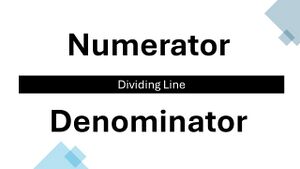Numerator and denominator

In fractions, the top and bottom values of the fraction are called the "numerator" (top) and "denominator"
Numerator
- numerator is at the top of the fraction
- the numerator represents the number being divided by another number
- i.e., = the same as saying,
Denominator
- the denominator is at the bottom of the fraction
- the denominator represents the number dividing into the other number
- .e., = the same as saying,



